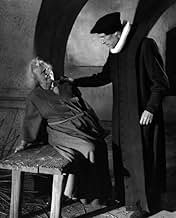AVALIAÇÃO DA IMDb
8,1/10
12 mil
SUA AVALIAÇÃO
A jovem esposa de um padre se apaixona por o filho dele no meio da caça das bruxas na Dinamarca do século XVII.A jovem esposa de um padre se apaixona por o filho dele no meio da caça das bruxas na Dinamarca do século XVII.A jovem esposa de um padre se apaixona por o filho dele no meio da caça das bruxas na Dinamarca do século XVII.
- Direção
- Roteiristas
- Artistas
- Prêmios
- 1 vitória e 1 indicação no total
Thorkild Roose
- Rev. Absalon Pederssøn
- (não creditado)
Lisbeth Movin
- Anne Pedersdotter (Absalon's second wife)
- (não creditado)
Sigrid Neiiendam
- Merete (Absalon's mother)
- (não creditado)
Albert Høeberg
- The Bishop
- (não creditado)
Preben Neergaard
- Degn
- (não creditado)
Anna Svierkier
- Herlofs Marte
- (não creditado)
Olaf Ussing
- Laurentius
- (não creditado)
Avaliação em destaque
Dreyer's feature from the 40's (he roughly made one in each of the last four decades of his life) is another example of his unique talent. Day of Wrath is less whitish than other of his films, but the director's trademark lighting is at it best here. The film has elements in common with The Passion f Joan D'Arc, dealing with a powerful leading female and matters of Grace, witchcraft and Puritanism.
Dreyer masters a somehow theatrical plot with pure mise-en-scéne, using constant intercutting between indoor and outdoor spaces. The oppression of the family house, determined by heavy shadows and a mummified environment, is superbly embodied by his actors, all of them complex and full of grey zones, people that hide the most of their performances, and whose deliveries are effective and economic thanks to Dreyer's direction. He seems to direct their eyes only, the barren faces around them becoming a sort of empty canvas. The family and the world surrounding it invoke questions of transcendence that their own fails and temporality contradicts. That temporality is portrayed by an ever-present tick tack of a wall clock. Anne's fall occurs not because of his sin, rather because of her submission to the transcendence of love that seems to be impossible in such a universe, where the possibility of a passion leads inevitably to a Passion, in strictly religious terms.
As in other Dreyer's films, simple actions become memorable moments through the director's portrait and comment of them, like when the young son drinks from Anne's hands like a docile dog or the lovers' kissing behind the grass. A fantastic personal film from one of the most remarkable and coherent filmmakers of all time.
Dreyer masters a somehow theatrical plot with pure mise-en-scéne, using constant intercutting between indoor and outdoor spaces. The oppression of the family house, determined by heavy shadows and a mummified environment, is superbly embodied by his actors, all of them complex and full of grey zones, people that hide the most of their performances, and whose deliveries are effective and economic thanks to Dreyer's direction. He seems to direct their eyes only, the barren faces around them becoming a sort of empty canvas. The family and the world surrounding it invoke questions of transcendence that their own fails and temporality contradicts. That temporality is portrayed by an ever-present tick tack of a wall clock. Anne's fall occurs not because of his sin, rather because of her submission to the transcendence of love that seems to be impossible in such a universe, where the possibility of a passion leads inevitably to a Passion, in strictly religious terms.
As in other Dreyer's films, simple actions become memorable moments through the director's portrait and comment of them, like when the young son drinks from Anne's hands like a docile dog or the lovers' kissing behind the grass. A fantastic personal film from one of the most remarkable and coherent filmmakers of all time.
- TheFerryman
- 14 de nov. de 2003
- Link permanente
Enredo
Você sabia?
- CuriosidadesThere was a gap of eleven years between this film and Dreyer's last feature, being Vampyr in 1932.
- Erros de gravaçãoThe film is set in 1623. But at the back of the main room, where much of the action takes place, is a large wooden chest with a Latin inscription: "Quodque parum novit nemo docere potest - Anno 1639."
- Citações
Anne Pedersdotter: I see through my tears, but no one comes to wipe them away.
- ConexõesEdited into Eventyret om dansk film 9: Lyspunkter under besættelsen - 1941-1944 (1996)
Principais escolhas
Faça login para avaliar e ver a lista de recomendações personalizadas
- How long is Day of Wrath?Fornecido pela Alexa
Detalhes
Bilheteria
- Faturamento bruto nos EUA e Canadá
- US$ 7.642
- Tempo de duração1 hora 37 minutos
- Cor
- Mixagem de som
- Proporção
- 1.37 : 1
Contribua para esta página
Sugerir uma alteração ou adicionar conteúdo ausente

























